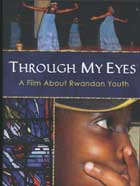
Through My Eyes: A Film About Rwandan Youth 2005
Distributed by Choices, Inc., 3740 Overland Ave., Ste. F, Los Angeles CA 90034; (310) 839-1500
Produced by Eric Kabera
Directed by Kavila Matu
DVD, color, 44 min.
Jr. High - Adult
African Studies, Education, Holocaust and Genocide Studies
Date Entered: 03/20/2007
Reviewed by Janis Tyhurst, Reference Librarian, George Fox UniversityBecause the logline on this DVD states “Rwandan youth use the arts to heal their nation after the 1994 genocide,” I was expecting to see how different artistic mediums helped to provide closure and hope to the Rwandans. However, the arts are a secondary, perhaps even a tertiary theme in the storyline. The major focus is on educating the youth of Rwanda and how education will help overcome the hatred of the past, as well as define their future. In spite of the focus on education, I felt like the storyline jumped around so much that the message being conveyed was unfocused and confusing.
The initial scene has university students visiting one of the Genocide museums to see the bones of some of those who died. Students are interviewed about their response to the museum display and how their attendance at the University sponsored Art Festival ties into their response to genocide. Other scenes include interviews with an abstract artist telling the story of his mother’s murder during the genocide, an aspiring singer/writer who is writing an African “Romeo and Juliet” story of marriage between a Hutu and a Tutsi, street children who demand to be educated, a 14 year old orphan girl taking care of her younger siblings and dreaming of becoming a doctor, and a Rwandan dance group that does hip hop music and dance in schools to talk about AIDS prevention. Education comes up again and again as the means of maintaining peace and teaching reconciliation, the route out of poverty and the means to fight the AIDS epidemic. One fascinating aspect in the film is how western looking many of the young Rwandans appear. Not only in the way they are dressed, but the hairstyles, the accessories and their activities (hip hop music and dance, abstract art, etc).
The cinematography in the film is excellent. One technique throughout the film was the use of split screens that show different aspects of the same scene. The English subtitles seem to capture the bare essence of the speakers. The narration is well done and necessary to help make the transition from one idea to another.
Because the film lacks a cohesive storyline, it is difficult to target an audience. There are some interesting facts about the Rwandan genocide, but not enough to be useful to a peace studies or African history program. The individual stories provide insight into the culture, but again, not enough for a cultural studies program. And the predominant theme of education is not explored in-depth, it is just repeated like a mantra or prayer for the future. It does provide a recent and superficial look at a cross section of Rwandan society ten years after a cataclysmic event that might be interesting to African Studies programs with money to spend.
Awards
- UNICEF Award , Zanzibar International Film Festival